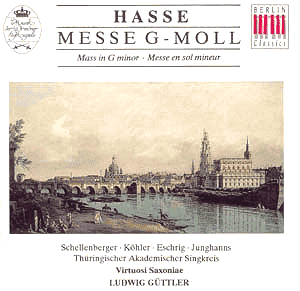Johann Adolf HASSE (1699-1783)
Mass in G Major [62.32]
Kyrie [9.53]
Gloria [27.41]
Credo [8.59]
Motetto [5.28]
Sanctus [5.54]
Agnus Dei [5.03]
 Dagmar Schellenberger,
soprano Dagmar Schellenberger,
soprano
Axel Köhler, alto
Ralph Eschrig, tenor
Egbert Junganns, bass
Thüringischer Akademischer Singkreis
Virtuosi Saxoniae/Ludwig Güttler
 BERLIN CLASSICS BC 1006-2
[62.32] BERLIN CLASSICS BC 1006-2
[62.32]
AmazonUK
AmazonUS |
 |
Opening with dramatic tension that recalls Mozart's requiem, this mass begins
with a large choir singing a majestic kyrie that seems to stretch out to
heaven itself. The tone is set for the rest of this work, which, however,
strays from its purely sacred sound. Essentially an operatic composer (he
composed more than 70 operas), Johann Adolf Hasse wrote this mass at the
very end of his life, while living in Venice, and it stands as his crowning
work.
Hasse was also a well-known teacher. His pupils included Haydn and the young
Mozart. It is not surprising that there are similarities among their musical
styles. Both elder composers venerated him as the padre della music
(the father of music). One of the leading exponents of the opera seria,
Hasse, whose work stands unjustly in the shadows of some of his counterparts,
shows here a wide variety of styles, melodies and orchestrations.
From the majestic opening movement, through the vast fugue that closes the
Kyrie, to the lavish Gloria, the centrepiece of the work, this is an anthology
of styles and forms. Its opening movement, which recalls some of Haendel's
more sumptuous music, begins with a sinfonia, before the choir joins and
timpani resound. Melodically, however, Hasse strays from the sacred tone
that some of the larger-scale movements present. In the Motetto, for example,
one can hear the influence of the opera seria aria, both in its
introduction and in the soprano's part. And, the Agnus Dei, the closing movement,
one which is usually a grandiose, moving piece, sounds like an opera aria,
with the choir joining in at the end, closing the work on a vastly different
tone than its opening.
This is not unattractive - far from it. But it does provide a strangely unequal
work, many of whose movements sound as if they are better suited for the
secular stage. Perhaps the best way to listen to this very appealing work
is to forget that it is a mass, and simply appreciate the music - at times
beautiful, at times poignant - and hear it for what it is: the crowning work
of a long career.
The excellent recording highlights the musicians perfectly. The choir sounds
a bit stifled at times; it is a large choir, and sometimes overwhelms the
instruments. All of the soloists are highly competent, and soprano Dagmar
Schellenberger is indeed excellent.
A fine recording of an attractive work by a little-known composer. Hasse,
teacher of Haydn and Mozart, was a master of the opera seria. This,
his final work, while sounding more like an opera than a mass, is beautiful
indeed.
Kirk McElhearn
CONTACT DETAILS
http://www.edelclassics.com
EDEL/Berlin Classics discs CANNOT yet be ordered directly from the
website. However it is probably worth browsing anyway:
You can try:-
EDEL affiliates in UK and USA:
edel UK ltd.
12, Oval Road
NW1 7DH London
phone: 0044 207 48 24 848
fax: 0044 207 48 24 846
edel America Records, Inc.
1790 Broadway, 7th Floor
New York, NY 10019
phone: 001 212 5419700
fax: 001 212 6648391

